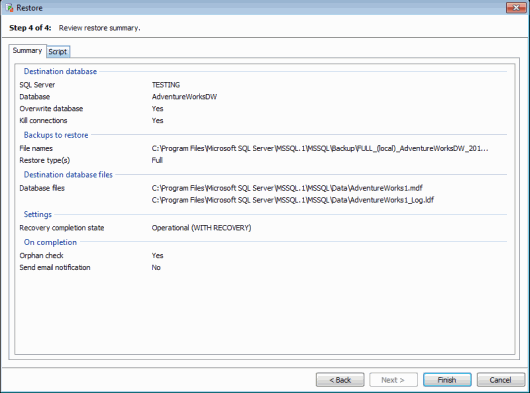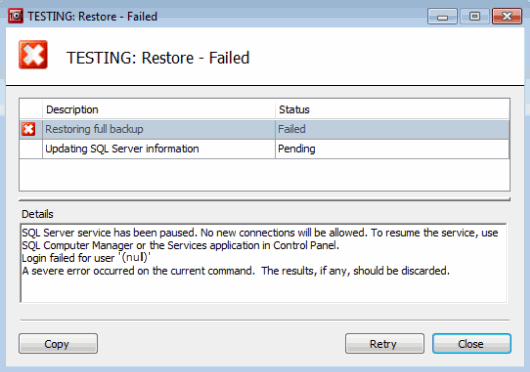Restoring backups - review summary
Published 13 February 2013
Restoring backups > Select backups > Destination database > Restore options > Review summary
On step 4 of the wizard, review your restore settings and, if required, copy the script.
The Summary tab displays a simple report of the options you have set for the restore operation, for you to check.
To see the script that will be used, click the Script tab.
You can then select the format in which to view the script:
- Extended stored procedure shows the script you can use to run the restore operation when you are connected to the server using an application such as Microsoft SQL Server Management Studio, or connectivity tools such as ADO, OLEDB, ODBC.For information about how you can use the SQL Backup Pro extended stored procedure to restore databases, see Using the extended stored procedure.
- Command line shows the script you can use to run the restore operation from the command line.For information about how you can use the SQL Backup Pro command line to restore databases, see Using the command line.
Refer to your SQL Server documentation for more information about backing up the tail of the transaction log.
When you have checked the settings, click Finish to start the restore process.
SQL Backup Pro displays a message dialog box that shows the progress of the restore operation. Click Hide to minimize this dialog box and continue working. You can display the box again by clicking the arrow in the SQL Backup Pro status bar.
The progress is also displayed in the In Progress tab.
When the restore process completes, if the message box is minimized, a pop-up message is displayed to inform you that the task is complete.
Information about the backup is then displayed in the Activity History. This information is also sent to a log file; you can view the contents of the log file by right-clicking the activity, and selecting Show Log. By default, log files are located in:
- %PROGRAMDATA%\Red Gate\SQL Backup\Log\<instance name> (Windows Vista, Windows 2008 and later), or
- %ALLUSERSPROFILE%\ Application Data\Red Gate\SQL Backup\Log\<instance name> (Windows XP and Windows 2003).
You can change this location in your log file options (see File management options).
If the restore process fails, you can optionally return to the final step of the wizard by clicking Retry in the message dialog. You can then change the settings in any of the wizard steps before starting the restore process again.








